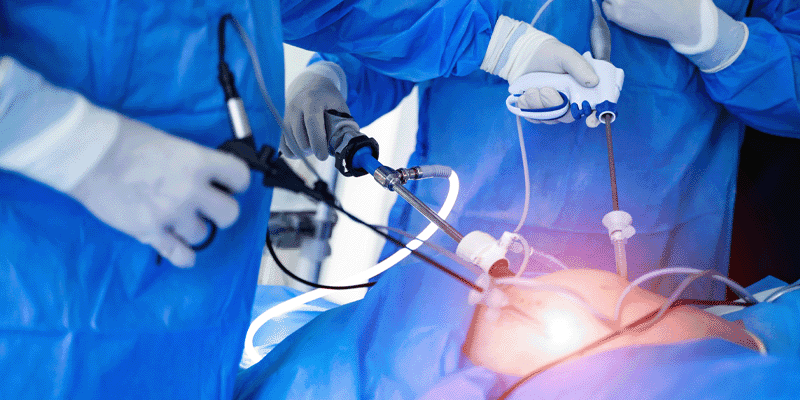How Much Does Laparoscopy Treatment Cost? Here's The Truth
In This Article
How Much Does Laparoscopy Treatment Cost? Here's The Truth
Sidharth
Updated on February 01, 2024
Medically verified by Dr. Arya
Fact checked by Dr. Sharon

Laparoscopic
9 min read
Laparoscopic surgery (commonly known as ‘keyhole surgery’) is one of the many advanced methods of surgery recommended by doctors nowadays. But you may be wondering; What is so advanced about this? How is it any different from the traditional method? Will it cost more because it is ‘advanced’?
To answer your questions, we’ll need to lay out the different conditions for which laparoscopic treatment is recommended. We’ll also discuss how it's different from open surgery and how that translates to the cost of the procedure.
Finally, we’ll talk about why you might want to choose laparoscopic surgery even though it costs more. But first, what exactly is laparoscopic surgery?
Understanding Laparoscopic Surgery
Laparoscopic surgery is a surgical method that uses tiny incisions to access your internal abdomen or pelvis. This is why it is also referred to as keyhole surgery or minimally invasive surgery.
The surgeon makes 2 to 4 incisions in the stomach (abdomen) area for this procedure. The first tube inserted is used to inflate your abdomen using carbon dioxide. This gives the surgeon a clear view of your organs and makes room for other surgical tools.
Then, a laparoscope is inserted through this tube. A laparoscope is a camera that relays visuals of your organs to a screen in the operating theatre. Now that the surgeon has a clear view of the area, they can insert the surgical equipment and guide them to the right spot for the operation. After the procedure, they let the carbon dioxide out and close the incisions using stitches.
Open surgery, on the other hand, is the traditional method where a single large incision is made to reach the internal organs. A bigger cut means you would need more stitches to close it. More stitches mean it would take longer to heal.
| Get back to your daily routine quicker with laparoscopic surgery. |
|---|
| In most cases, you can return home the very same day! |
How Much Do Laparoscopic Surgeries Actually Cost?
Let's take a closer look at how laparoscopic surgeries have become the modern choice for various health conditions. We'll also compare the prices for both open and laparoscopic surgeries.
Hysterectomy:
A hysterectomy is a medical procedure where the uterus is removed from a person's body. Hysterectomy is often used to treat conditions like fibroids, endometriosis (a condition where tissue similar to the lining of the uterus grows outside of it), and abnormal bleeding from the uterus.
Laparoscopic hysterectomy is a modern approach to solving these health issues. In India, the cost of a traditional open hysterectomy can range from ₹55,000 to ₹75,000. The laparoscopic method of surgery might cost between ₹85,000 to ₹1,20,000.
Appendectomy:
Acute appendicitis is a situation where the appendix, a small pouch in your lower belly, becomes inflamed and causes discomfort. To fix this, surgeons usually recommend a laparoscopic appendectomy. This involves making small incisions instead of a large cut. We'll use special tools and a camera to carefully remove the inflamed appendix. This method usually means a smoother recovery with smaller scars.
Open appendectomy in India costs about ₹40,000 to ₹60,000, while laparoscopic appendectomy ranges from ₹70,000 to ₹1,50,000.
Hernia Repair:
A hernia is when part of your insides pushes through a weak spot in your abdominal muscles. To fix it, we use laparoscopic hernia repair. This means we make small cuts and use special tools to fix the hernia. It usually costs between ₹80,000 to ₹1,50,000 in India. Open hernia repair, where we make a bigger cut, might cost between ₹60,000 to ₹1,20,000.
Cholecystectomy:
Gallstones are small, hard particles that can form in your gallbladder, which is a small organ in your belly that helps with digestion. Sometimes, these gallstones can cause pain and other problems. If you have issues like persistent pain, inflammation, or infection related to your gallbladder, your doctor might recommend a cholecystectomy. This is a surgery to remove the gallbladder.
In the past, this surgery was done with a larger cut in the belly, but now we often use a laparoscopic approach. This means making smaller cuts and using special tools to remove the gallbladder. It's less invasive and usually leads to a faster recovery. The cost for the older open surgery could be around ₹50,000 to ₹70,000 in India, while the laparoscopic approach might cost between ₹90,000 to ₹1,80,000.
Making Informed Choices: Considering Benefits and Costs
Regular open surgeries can cost anywhere from ₹50,000 to ₹1,20,000 or even more. On the other hand, laparoscopic surgery might be a bit more expensive, ranging from ₹70,000 to ₹2,00,000.
But remember, it's really important to work with your doctor to choose the right option. Think about what's best for you, what risks there might be, and how much laparoscopic surgery could help.
| Surgery | Cost of Open Surgery | Cost of Laparoscopic Surgery |
|---|---|---|
| Hysterectomy | ₹ 55,000 to ₹ 85,000 | ₹ 90,000 to ₹ 1,20,000 |
| Appendectomy | ₹ 40,000 to ₹ 70,000 | ₹ 70,000 to ₹ 1,50,000 |
| Hernia Repair | ₹ 45,000 to ₹ 60,000 | ₹ 70,000 to ₹ 1,30,000 |
| Cholecystectomy | ₹ 50,000 to ₹ 70,000 | ₹ 90,000 to ₹ 1,80,000 |
Also Read : laparoscopy for infertility
 9 min read
9 min readTop 9 Things To Know About Laparoscopic Treatment for Pregnancy
 8 min read
8 min readTreatment After Laparoscopy for Pregnancy - What You Need to Know
 8 min read
8 min readThings To Be Mindful Of Recovery After Laparoscopic IUI Treatment
Get a Callback Now
Why is Laparoscopic Surgery More Expensive?
Specialised Equipment: Laparoscopic surgery uses special tools and a camera through small cuts. These tools are advanced and can be expensive.
Surgeon's Expertise: Surgeons who do laparoscopic surgery need special training. They might ask for higher fees because they're experts in this kind of surgery.
Longer Procedure Time: Laparoscopic surgery can take more time because it's a bit tricky. This can make the surgery cost more because you're using the operating room for longer.
Operating Room Setup: Before the surgery, they need to set up the room with special tools and screens. This setup can cost extra compared to regular surgery.
Anesthesia and Monitoring: Laparoscopic surgery requires general anaesthesia, which costs more than local anaesthesia.
Why Choose Laparoscopic Surgery Despite the Higher Cost?
Recover Faster: One big plus is that you might recover quicker. Because the cuts are small, your body might feel better sooner compared to the bigger cuts in regular surgery.
Less Pain: Smaller cuts also usually mean less pain after the operation. This can make your recovery more comfy and might mean you need fewer pain pills.
Minimal Scars: The small cuts leave smaller scars. This is better for how it looks, and it might lower the risk of problems like infections.
Lower Risk of Infections: With small cuts, the chance of getting an infection is lower. This is important because infections can lead to more doctor visits and a longer recovery time.
Back to Normal Faster: Because you might heal faster and have less pain, people who have laparoscopic surgery often get back to their regular activities and work sooner. This makes it easier to keep up with your usual routine.
Shorter Hospital Stays: Laparoscopic surgery usually means you stay in the hospital for a shorter time. This saves you money on the hospital bill and helps you go back home sooner.
Save Money in the Long Run: Even though it might cost more at first, the fact that you recover faster, have fewer problems, and don't need as many medications can save you money over time. While it costs more right away, the care you need afterward tends to be less expensive.
| Experience | Open Surgery | Laparoscopic Surgery |
|---|---|---|
| Scars | Large | Small |
| Blood | More | Less |
| Hospital Stay | 4-7 days | 1-2 days |
| Recovery | 1-2 weeks | 3-5 weeks |
Is Laparoscopic Surgery Covered by Insurance?
The good news is that laparoscopic surgery is generally covered by most health insurance plans. However, there are a few factors to consider:
Insurance Type: The extent of coverage can vary based on your insurance plan. Be sure to review your policy to understand what is covered and what might be considered an out-of-pocket expense.
In-Network vs. Out-of-Network: Choosing a surgeon and hospital that are in-network with your insurance provider can really impact your coverage. Out-of-network providers may result in higher costs.
Pre-Approval: Some insurance plans require pre-approval or prior authorization for elective surgeries like laparoscopy. It's crucial to check with your insurance company and get the necessary approvals if required.
Understanding Deductibles, Copayments, and Coinsurance
When discussing insurance coverage, it's essential to understand a few key terms:
Deductible: This is the amount you have to pay out of pocket before your insurance starts covering your medical expenses. Check your policy to know your deductible amount.
Copayment: A copayment is a fixed amount you pay for specific medical services, such as doctor's visits or hospital stays. Your policy will specify these amounts.
Coinsurance: Coinsurance is a percentage of the costs you share with your insurance company after meeting your deductible. For example, if your policy has a 20% coinsurance, you pay 20% of the covered costs, and your insurance covers the rest.
Now, let's talk about something important. It's a good idea to keep a careful record of everything related to your surgery. This means keeping copies of any letters or emails you get from your insurance company. It also means holding onto any bills or receipts you get from the hospital or pharmacy.
Think of it like this: if we have a map, we can always find our way. These records are like your map. They can help if there are any questions or disagreements later on.
Know more about laparoscopy for infertility cost in india
Laparoscopic Surgery: Also known as minimally invasive surgery, uses small cuts and a laparoscope for clear internal viewing.
Various Procedures: It's used for operations like hysterectomy, appendectomy, hernia repair, and cholecystectomy, with benefits that vary for each.
Cost Overview: Regular open surgeries can cost anywhere from ₹50,000 to ₹1,20,000 or even more. On the other hand, laparoscopic surgery might be a bit more expensive, ranging from ₹70,000 to ₹2,00,000.
Factors Affecting Cost: Special equipments, Type of anaesthesia, Longer procedure time, Surgeon's expertise
Balancing Value and Cost: Laparoscopic surgery may cost more, but it offers faster healing, less pain, smaller scars, lower infection risk, and quicker return to regular activities.
Long-Term Savings: Even though initial costs can be higher, the speedier recovery, shorter hospital stay, and reduced need for medication often result in overall savings in the long term.
Personalised Decision: Always talk to your healthcare provider to choose the right surgery for your specific situation, keeping both your finances and health in mind.
Source Links
Health Price.in
PACE HOSPITALS
Health Price.in



